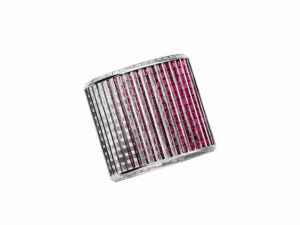
A lawsuit was recently filed in the United States District Court for the Southern District of New York against Tiffany & Co. for patent infringement. The complaint, filed by Jacob’s Jewelry Co. Ltd. cites its utility patent, United States Patent No. 9,609,923, for a “Color Changing Multiple Stone Setting.” At issue is a nearly $1 million pink sapphire and diamond bracelet from Tiffany & Co.’s 2016 Masterpieces Collection. While Jacob’s Jewelry claims to have been making and marketing color changing jewelry since several years prior to the issuance of its patent, the jewelry products covered by the patent allegedly “have proved to be commercially successful and valuable to Jacob’s.”
The patent asserted by Jacob’s Jewelry was filed on January 25, 2011 and granted on April 4, 2017. In the background, the applicant explains that jewelry is often created so as to enhance the appearance of individual gems contained therein. For instance, complementary stones are often mounted relative to a center stone so as to reflect or refract light in a manner that enhances the natural beauty of the center stone. Another means of accomplishing jewelry with an enhanced appearance is by way of color changing jewelry. Such pieces comprise stones that exhibit a color change when viewed in different lighting conditions, such as incandescent light, fluorescent light, sunny outdoors, cloudy outdoors, or shady outdoors. Moreover, certain stones are used to accomplish this, including alexandrite, iolite, sapphire, and garnet. Alternatively, some jewelry makers apply a coating to gems which changes color depending on the viewing angle of the observer.
In its most basic form, the patent asserted by Jacob’s Jewelry comprises three color-changing surfaces, including a first stone, a second stone, and a third stone, each set on a different plane and perpendicular to one another. The stones may be set on a base formed of a single piece or that which is formed by joining several separate pieces. Each of the first, second, and third stones face outward (presumably so as to be visible to an observer and the wearer) and change to different colors as the viewing angle changes. Further, the stones are capable of two- or three-color changes.
Utility patents protect the functional aspects of an invention and are the most common type of patent applications. Utility patents provide broad protection for multiple different variations of a product. On the other hand, design patents cover only the ornamental design of a patent. However, design patents are less expensive than utility patents and often receive protection more quickly than do utility patents. That being said, design patents can be relatively easy to design around so as to avoid infringement. In this manner, different variations of a product are typically not protected by a design patent.
Patent infringement occurs when one makes, uses, offers to sell, or sells something that contains every element of a patented claim or its equivalent while the patent is in effect. Patent infringement is willful when the complained of conduct is done deliberately and intentionally and with knowledge of the patent. If found liable for willful patent infringement, a defendant may be held liable for up to three times the amount of damages. Jacob’s Jewelry alleges Tiffany & Co. not only infringes its patent but does so willfully and deliberately. In particular, Jacob’s previously contacted Tiffany & Co. regarding the alleged infringement. According to Jacob’s, Tiffany & Co. “has not denied the [bracelet] do not infringe on the [] Patent.” Further, because Tiffany & Co. has been made aware of these accusations but has “taken no action to cease their knowing infringement,” its actions are intentional.
In the complaint, Jacob’s Jewelry seeks not only a judgment of infringement by Tiffany & Co., but also that such alleged acts of infringement be held willful and deliberate. The plaintiff also desires Tiffany & Co. to be enjoined from further infringement of the patent, which should not be problematic (should Jacob’s prevail) since the complained-of piece was from Tiffany & Co.’s 2016 collection. Jacob’s further seeks attorney’s fees, costs, and damages in the form of a reasonable royalty. Reasonable royalty is calculated as the royalty that Tiffany & Co. would have agreed to pay had there been no infringement suit but instead, a prior agreement between the parties. While no answer has been filed by Tiffany & Co. yet, according to the complaint, the 182-year old jewelry brand’s position is that the patent at issue is invalid in light of the Cartier Tourmaline brooch dating back to the 1940’s.
